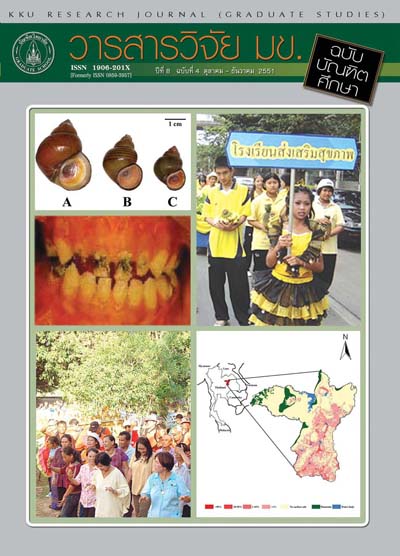Developing a Model for Communities with Green and Happiness in the Rural Villages of E-San (Northeast Region)(การพัฒนารูปแบบชุมชนอยู่เย็นเป็นสุขในหมู่บ้านชนบทอีสาน)
Keywords:
Green and Happiness(อยู่เย็นเป็นสุข), Developing a model(การพัฒนารูปแบบ), The rural villages of E-San(ชนบทอีสาน)Abstract
การศึกษาในครั้งนี้ มีจุดมุ่งหมายสำคัญเพื่อพัฒนารูปแบบชุมชนอยู่เย็นเป็นสุขในหมู่บ้านชนบทอีสาน โดยใช้รูปแบบการวิจัยแบบผสม เชิงปริมาณและเชิงคุณภาพ ศึกษาจากผู้ทรงคุณวุฒิ 20 คน และกลุ่มตัวอย่าง คือผู้ปฏิบัติในชุมชน 72 คน และ ผู้นำองค์กรชุมชน 365 คน ได้จากการสุ่มแบบหลายขั้นตอน หัวหน้าครัวเรือน 360 คนได้จากการสุ่มเป็นระบบ เครื่องมือที่ใช้ในการศึกษาประกอบด้วย แบบสอบถาม แบบสัมภาษณ์ และ แบบสนทนากลุ่ม วิเคราะห์ข้อมูลด้วย สถิติพรรณนา การวิเคราะห์ความแปรปรวนแบบพหุนาม (MANOVA) และใช้การวิเคราะห์แบบลดหลั่นตัวแปร (Step down) ด้วยการวิเคราะห์ความแปรปรวนร่วมแบบเอกนาม (one-way ANCOVA) ใช้โปรแกรม SPSS For Windows การวิเคราะห์ยืนยันองค์ประกอบ และตรวจสอบความเหมาะสมพอดีของโมเดลสมมุติฐานกับข้อมูลเชิงประจักษ์ ใช้โปรแกรม LISREL Version 8.30 ผลการวิจัย พบว่า ชุมชนอยู่เย็นเป็นสุขในหมู่บ้านชนบทอีสานมี 6 องค์ประกอบหลัก 22 องค์ประกอบย่อย 107 ตัวชี้วัด คือ องค์ประกอบด้านสิ่งแวดล้อมและทรัพยากรธรรมชาติที่ดี 14 ตัวชี้วัด องค์ประกอบด้านสุขภาพดี 20 ตัวชี้วัด องค์ประกอบด้านเศรษฐกิจชุมชนเข้มแข็ง13 ตัวชี้วัด องค์ประกอบด้านเทคโนโลยี ภูมิปัญญา และการเรียนรู้ที่เหมาะสม 19 ตัวชี้วัด องค์ประกอบด้านสังคมวัฒนธรรมดีมีคุณธรรม 24 ตัวชี้วัด และองค์ประกอบด้านการบริหารจัดการชุมชนที่เข้มแข็ง 17 ตัวชี้วัด โมเดลชุมชนอยู่เย็นเป็นสุขมีความเหมาะสมพอดีกับข้อมูลเชิงประจักษ์ (ค่า χ2= 2807.14 , GFI=.91, AGFI = .91 และ RMSEA = 0.000) ผลการประเมินความอยู่เย็นเป็นสุขของชุมชนโดยภาพรวมอยู่ในระดับมาก การเปรียบเทียบคะแนนเฉลี่ยชุมชนอยู่เย็นเป็นสุขโดยรวมและรายองค์ประกอบในชุมชนพื้นที่ต่างกัน มีความแตกต่างกันอย่างมีนัยสำคัญทางสถิติที่ระดับ.01 และรูปแบบและแนวทางการพัฒนาชุมชนอยู่เย็นเป็นสุขที่เหมาะสม มี 21 แนวทาง 71 กิจกรรมหลัก โดยสรุป โมเดลชุมชนอยู่เย็นเป็นสุขจากผลการศึกษามีความเหมาะสมที่จะนำไปใช้เป็นรูปแบบในการพัฒนาชุมชนอยู่เย็นเป็นสุขในระดับหมู่บ้านชนบท ต่อไป
The purpose of this study was to develop a model of Green and happiness community for the rural villages of E-San (Northeast region). The research design was consisted of both quantitative and qualitative analyzes .The study was carried out with 20 resource persons and the samples of 72 operators in communities, 365 community leaders selected by multi-stage sampling, and 360 heads of families selected by systematic sampling. The research instruments were questionnaires, interviews and focus groups. The data were analyzed by using descriptive statistics, MANOVA, and one-way ANCOVA with the use of SPSS for Window. For the confirmatory factor analysis and the test of hypothesized model to fit the empirical data, LISREL Program version 8.30 was applied. The research results revealed that, regarding the communities with Green and happiness in the rural villages of E-San, there were 6 factors and 22 sub-factors and 107 indicators. They were 14 indicators for the factor of good environment and natural resources, 20 indicators for the factor of good health, 13 indicators for the factor of strong community economy, 19 indicators for the factor of appropriate technology, wisdom and learning, 24 indicators for good society and culture with morality, and 17 indicators for the factor of strong community administration and management. The model for communities with Green and happiness was fitted with the empirical data (χ2= 2807.14, GFI=.91, AGFI = .91 and RMSEA = 0.000). All 6 main factors had statistical significance at the level of .05. Each factor was mutually related with statistical significance at the level of .05. As regarding the evaluation, the Green and happiness of communities was generally at a high level. The comparison of the means of Green and happiness among different areas show that the means were different with statistical significance at the level of .01. For the appropriate model and guidelines for developing communities with green and happiness according there were 21 guidelines for development and 71 major activities. In conclusion, the model for communities with Green and happiness from the results of study, it is appropriate to bring the model into practice in developing communities with Green and happiness in the rural villages.



